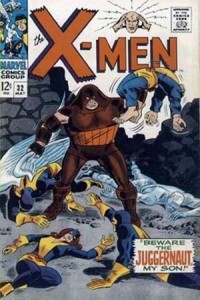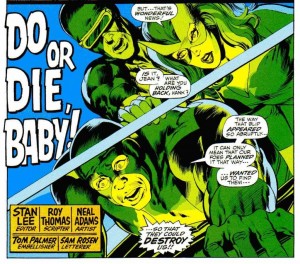This volume includes issues 32 – 42 of the original run of X-Men, published between July, 1967 and March, 1968. This span marks a transition from the X-Men as they were created by Stan Lee and Jack Kirby—Students in matching yellow and black (or was it blue? It’s hard to tell in comics of that era) uniforms—to the four-color team made famous on down the line by Roy Thomas, Neal Adams and Tom Palmer.
The first nine issues in the collection comprise the end of the X-Men’s first epic storyline, the battle with the mutant underground army called Factor Three. By this time, Roy Thomas had taken over the writing chores on the book from Stan Lee, as he had done on Avengers. Stan was, at the time, focusing on editing and promotional duties, and had pretty much cut back to writing only his signature book, Fantastic Four. Jack Kirby had likewise ceased drawing the book (although comics historians maintain he continued to draw breakdowns—sketched layouts for each page—on just about every book Marvel published.) In his place came Werner Roth (AKA Jay Gavin), one of my favorite Silver Age artists. (I don’t count Neal Adams as Silver Age. For me, the Bronze Age began in 1968—one of these days I’ll write a piece on why I think so.)
Roth’s style was not ultra-realistic, but was clean and very expressive. He made the X-Men look like people wearing clothes, not models in sprayed-on getup. He also managed to draw Jean Grey as an extremely attractive young lady, a feat which, sadly, was not King Kirby’s forte. He still, as did all Silver Age artists, drew teenage boys so broad-shouldered and barrel-chested that they looked like 40-year-old men who just didn’t happen to shave. Oh well, with John Tartaglione’s inks, Roth still gave the X-Men a look all their own. And even when he gave up drawing the main tales, he hung around for the entirety of the “Origins of the X-Men” series, which ran from issue 38 to issue 57.
At this point in their history, all the teen X-Men are hooked up. Even though they haven’t said the words, Scott (Cyclops) knows he loves Jean (Marvel Girl). She know she loves Scott, and they’re starting to have an inkling about each others’ feelings, even though Scott is still given to saying demeaning things like “This isn’t the time for personal feelings, girl,” when, in the height of battle, she expresses concern for his safety. Hank (The Beast) and Bobby (Iceman) have Vera and Zelda, who accompany them to coffee shops in Greenwich Village, and the Angel’s childhood sweetheart Candy Sothern is introduced for the first time in these very pages. Of course, they still are maintaining “secret identities,” so, non of the non-mutant paramours have a clue they’re dating X-Men.
There are villains classic and non-classic in these pages, and high-powered guest stars. Professor X tries to free his stepbrother of the power of the Juggernaut, and Dr. Strange shows up to help deal with the mystic powers of Cyttorak, the mystic gem that empowered the Juggernaut to begin with. The Professor is kidnapped by Factor Three, which was introduced in issue 28. They’re advised along the way by the Banshee, a former foe; but, before they can search for Xavier, the X-Men are roped into a battle between the Mole Man and Tyrannus, a Fantastic Four and a Hulk villain, respectively. Spider-Man guest-stars, and, because this is Marvel, is assumed by the team to be an agent of Factor Three. (The Spider-Man story is Roth’s last on the main feature. Ross Andru filled in for an issue, and then Don Heck took over the pencilling.)
Not all the villains are memorable. The X-Men take a construction job in order to earn money to buy plane tickets to Europe. They believe Professor X has been taken there. Again, a very Marvel touch–they didn’t simply ring Tony Stark or Reed Richards and ask for a lift. On the job, the X-Men encounter the forgettable Mekano, a pissed-off rich kid in an exo-suit. They defeat him, and are rewarded by his grateful father with plane tickets to Europe.
Here the battle with Factor Three moves into high gear, and the X-Men are put on trial by a jury of old foes–Unus the Untouchable, The Vanisher, Mastermind, The Blob, and newcomers The Changeling and The Master, head of Factor Three. Found guilty of crimes against mutantkind, they are sentenced to a kind of high-tech lobotomy. They escape, of course, and, with the aid of the Banshee, defeat Factor Three and its leader, who is actually an alien from Sirius bent on wiping out all humans and mutants on Earth.
As a reward for their success, the X-Men are given colorful new costumes. They’re designed by Jean, of course, because she’s a girl. (Later it would be revealed that Hank McCoy, the Beast, is the one with the eye for fashion in the group.) Don Heck presumably designed these costumes, and they served the team well, especially when Neal Adams drew them in later issues. (Adams did replace Angel’s rather garish garb–twice, in fact.)
There’s a throwaway tale of finding the Frankenstein monster, who turns out to be an android. This story seems to have no tie to the later, ongoing Monster of Frankenstein series that Marvel published. Does anyone know of one? Finally (can’t really call it a spoiler, because it’s on the cover) there’s the DEATH OF PROFESSOR X! NOT A DREAM! NOT A HOAX! NOT AN IMAGINARY STORY! Of course, Marvel never did imaginary stories. That was the Distinguished Competition’s forte. And it did turn out to be a hoax, the seeds of which were planted in the same issue where Charles Xavier “dies.”
Interesting touch in Xavier’s “death” scene in issue 42–he walks to face his opponent, the Subhuman called Grotesk, on artificial legs, which we’re told, in a throwaway comment that he had invented. I recall reading this story for the first time late one night after a back-issue-buying binge at Geppi’s Comic World (when it was still in Steve Geppi’s basement in Catonsville.) I was dozing over the issue, and later wondered if Xavier walking was a product of my twilit imagination. But it’s there. The legs, to my knowledge, were never mentioned again. I always wondered why Xavier didn’t use them more often.
Grotesk is a tragic figure, the prince of an underground world which was destroyed by nuclear testing. He’s the last survivor, and he’s been driven mad. It’s reminiscent of the Golden Age character Rock Man, who was included in J. Michael Straszinski’s series The Twelve. Roy Thomas had a penchant for mining the Golden Age stories, so the resemblance may have been intentional. Thomas used a similar tragic motif when he brought back the Fifties hero Marvel Boy as The Crusader in the pages of The Fantastic Four.
Included in the back pages of these issues were the first five “Origins of the X-Men” stories, detailing how Charles Xavier became connecting with the FBI, and how he found the first of his students, a young orphan named Scott Summers.
This volume really marks the end of school days and childhood for the X-Men. In future issues, they would disband and face, without their mentor, a world increasingly hostile to them and their kind. The stories would become at once more intimate and more threatening, and the X-Men would be part of the adult world. Truly, this was the last stand of Lee and Kirby’s original concept, and it’s fun, classic, Silver Age Marvel at its finest.



Not a single luxury?
Somewhere I actually have that issue with Mekano. It really is a throwaway issue with a forgettable villain, but it has a great scene that I’ve really held onto for years. Angel and Cyclops have just changed into their outfits when a security guard surprises them with his gun drawn. Angel looks at him and says, “Now how do we get out of this without hurting anyone?”
It’s a line of dialogue that really encapsulates so much of what is right about well-written superheroes:
1. Superheroes know full well that what they do is illegal (in this case they were just standing there, but they clearly allowed that the guard had a point.)
2. It acknowledged their own abilities, in this case that they could easily extricate themselves from the situation.
3. It also acknowledged that the guard had a deadly weapon, so they would have to amp up their response accordingly. A gun would prove no challenge for them, it was neutralizing the threat while protecting the innocent that would pose the challenge. And superheroes protect the innocent.
Fortunately a telekinetic relieved the guard of his gun, because she needed extra time to change (while the guy with wings didn’t) because, yeah, she was just a girl. Some things are worth forgetting.